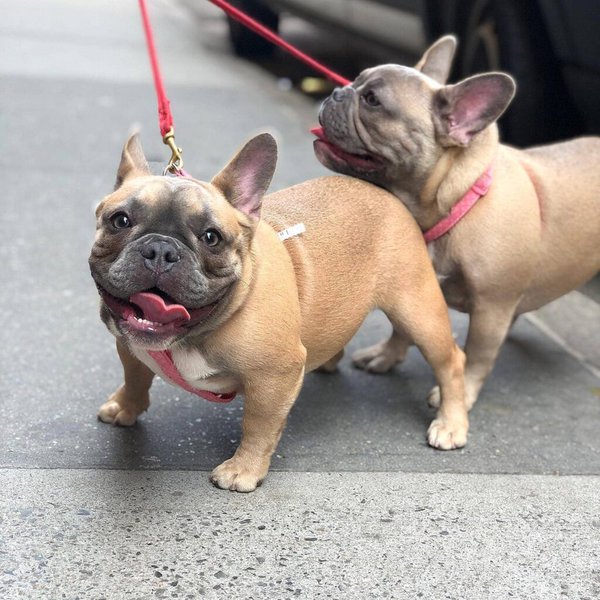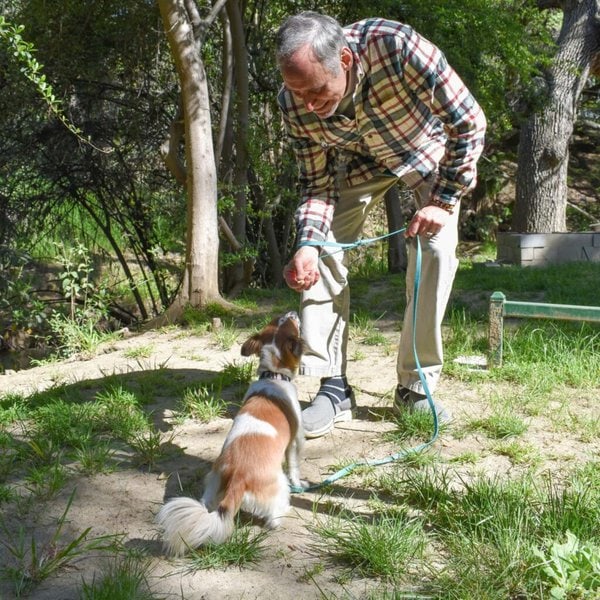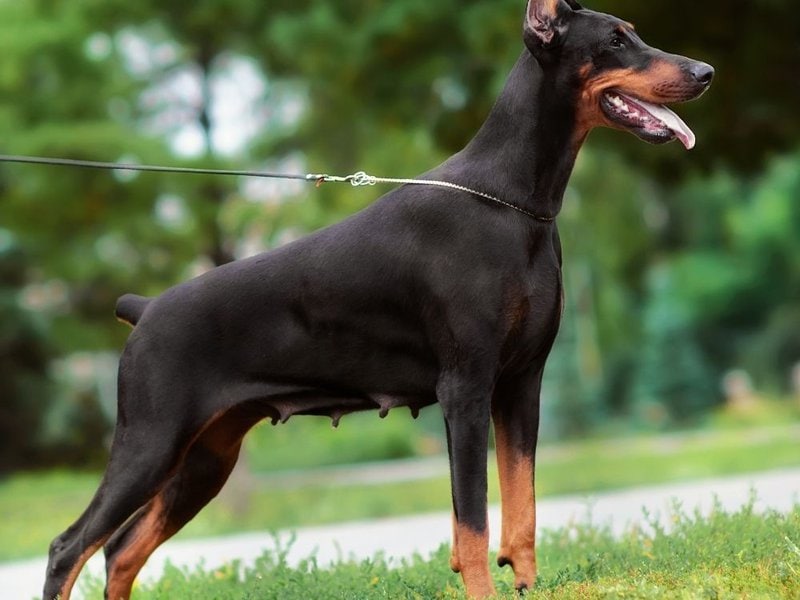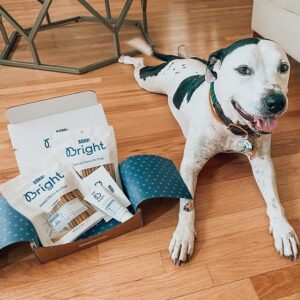The best slip lead for dogs is Friends Forever Mountain Climbing Rope Lead.
It’s never easy to walk your pooch that pulls a lot. But then again, it’s nothing that the best slip leads for dogs cannot solve.
Perfect for walking and training your dog, a slip lead makes life easier for every canine owner. Let’s take a look at your best options and why they’re great.
#1 Friends Forever Mountain Climbing Rope Lead
Whether you have a small or large pup, this slip lead does the job. It is a one-size-fits-all slip leash that will suit your pooch nicely. It comes with an adjustable loop, so it’s a breeze to tighten or loosen as needed. This slip lead is lightweight and made of a mountain climbing rope. That’s why it is solid and durable for all your outdoor adventures.
Another great thing about this slip lead is the reflective material. This safety feature enhances your pup’s visibility during those night walks. The reflector also blends perfectly well with the color of the cord. Motorists can easily spot you and your canine buddy during dim light situations. Great for potty breaks, training, and walking your pet, it’s a versatile slip lead you can count on anytime. Plus, you don’t even have to use a harness or collar along with this slip lead.
This is hands down one of the finest – if not the best – slip leads for an active dog. It holds up quite well because of the durable material, so you can expect it to last for a long time. Thus, it is a great value for your money.
Pros
- The rope lead measures 72 (6 feet) x 0.5 x 0.5 inches and is available in 6 different colors, making it suitable for all dog breeds.
- This lead is made of lightweight but sturdy polyester mountain climbing rope, which can hold any doggie size without breaking.
- The lead is waterproof such that you can use it under any weather condition, and you can easily machine wash it to keep it clean.
- It has an adjustable noose to facilitate the ease of fitting based on your pup’s size and needs, and it comes with a choke guard buckle to protect your pup from choking or neck injuries.
- The threads are reflective, and this makes them easy to use in low-light conditions.
Cons
- The leather buckle can come off, and this can lead to your pup choking on the lead.
- The lead is rather long for some users, so they are forced to wrap it around their hands with any type of traction.
We vote this product to be our top pick because of its lightweight, waterproof rope material that is graded for heavy-duty mountain climbing, and its 6-ft long and 0.5-inch thick cord that provides dogs increased freedom to roam and run around.
#2 iYoShop Slip Dog Rope Leash
If what you need is a dependable slip leash that won’t break the bank, the iYoShop meets you where you’re at, budget-wise. This is why it’s our pick for budget-conscious folks. But it’s not just the price tag that’s great about it – this slip leash actually works. It can handle up to 150 pounds of weight, even if you have a hyperactive puller pooch.
This is a two-in-one item – a collar and a leash rolled into one. There is no need to fumble with intricate collar loops and leash hooks. What’s more, there is a padded handle to give you a comfortable and secure grip. You can even wrap it around your hand to make sure it does not slip away. The metal clasp also prevents the slip leash from breaking off to give you peace of mind as you walk your energetic canine pal.
This is an all-weather slip leash that’s been tested to hold up to 1,000 pounds of pulling strength. Thus, you can be sure your pooch does not break loose or wander off. Most importantly, it is gentle on your hands while giving you perfect control each time.
Pros
- This 6-ft rope leash is made of ½-inch thick nylon rock climbing rope that comfortably caters to medium to large doggie breeds of up to 130 lbs and is available in 10 colors.
- It functions as a collar and leash thanks to the adjustable metal collar and no-choke stopper, which helps you easily adjust the leash while protecting your pup from choking.
- It is comfortable for holding and wrapping around your hand during use, as it comes with a padded handle.
- It is made with luminous reflective threads, which are perfect for use in low-light conditions.
- Comes with a removable zipper pouch, from which you can store keys and other items during your walks.
Cons
- It is not fully safe for aggressive doggies or those that strongly pull at their leashes, as it can cause some injuries to your pup.
- The metal ring on the leash is not welded together and comes apart after using it for some time.
#3 BAAPET 6 Feet Slip Lead Dog Leash
When you need a slip lead that addresses a pulling behavior without choking your pet, the Baapet is a suitable choice to consider. It comes with an anti-choking clasp that lets you adjust the tightness easily. You can loosen it as you wish, depending on your pet’s neck circumference. But at the same time, it is still snug enough to discourage pulling.
Unlike inferior rope cover, this product does not use glue or other materials with a strong and harsh smell. It comes with a sturdy leather stopper and a robust rope cover that will last for a long time.
This slip leash from Baapet is a combination of a rope cover and a leather stopper to ensure optimum durability. It also comes with a metal O-ring for connecting the bag dispenser as an additional convenient feature.
Pros
- This ‘one size fits all’ leash is 6 feet long and is made of ½-inch thick nylon rock climbing rope, with makes it strong and durable for use on most doggie breeds, and it comes in 9 colors that you can choose from.
- It has a thick cushion padded handle that you can hold on to or wrap around your hand comfortably without worrying about burns or cuts.
- It has a heavy-duty leather stopper that helps to adjust the leash and also an anti-choking metal ring that protects your pup from any choking accidents during walks.
- The rope has reflective threads for visibility in low-light conditions.
- Comes with a poop bag dispenser containing 20 bags, and it can easily be attached to the leash for use while out for walks.
Cons
- It is too long and thick for smaller doggie breeds.
- The leather stopper near the padded handle easily comes off.
#4 Mendota Products Dog Slip Lead
Training a pup to stop pulling is much easier to do with the Mendota slip lead. The 6-ft model is perfect for smaller dogs, while the 4-ft one is ideal for large breeds to give you better control. This slip lead is adjustable, allowing you to fit it on your pooch based on the tightness you prefer. After use, simply remove it in seconds and throw it into the washer for a quick, hassle-free cleaning.
Pet owners will love how soft the handle is to their hands. You can even roll it up to gain better control, thanks to its pliable quality. No more burning hands from rough slip leads from now on!
The Mendota slip lead is handcrafted and durable. It works for all shapes and sizes of canines. Best of all, you can conveniently put it in the washer after use for a hassle-free cleanup.
Pros
- This slip lead is made of ⅜-inch-thick Polypropylene rope, comes in either 4-ft or 6-ft lengths for smaller doggies, and has a whopping 37 colors to choose from.
- It can be used both as a leash or a collar and can fit on doggies of up to 50 lbs, and is perfect for pup training and doggie walks.
- The handle is soft and gentle on and around your hand and has a leather stopper to keep the handle in place.
- The slip lead is waterproof and easy to clean in a washing machine.
- This handmade lead has leather splices, as well as brass, satin nickel, or black metallic hardware to give it a rustic finish.
Cons
- It can cause neck injury if your doggie is a puller due to the thin design of the lead.
- The leather splice does not easily move up and down the lead, which means it can tighten and harm your pup.
#5 Wellbro Real Leather Slip Lead Dog Leash
Attractive and practical, the Wellbro slip lead is leather-made. This is undeniably sturdy while providing comfort to your pet. It comes with soft, genuine leather with solid stitching to prevent it from fraying. The material also prevents it from pulling on your pet’s hair. This adds comfort while discouraging your pooch from pulling during your walk.
Suitable for traveling, training, or walking, this slip lead is multi-purpose. It can also fit on your pet’s neck by simply adjusting the collar loop. Easy to clean, comfortable, and durable, this slip lead lets you stay in control of your canine buddy in a humane, ethical way.
This is a multipurpose slip lead that’s perfect for travel, walking, and training your dog. It is also leather-made, which adds to its chic appeal and maximum durability.
Pros
- This dog leash is ¾ inch wide, ⅕ inch thick, and 5 feet long, which makes it suitable for most doggie breeds for training or taking walks.
- It is durable as it is made of soft and pliable real leather that is cut from a single cowhide piece, all with smooth edges.
- You can use it as a collar or leash and all you have to do is use the riveted leather sliders and steel ring to properly adjust it to fit your doggie’s needs.
- It has a classic design thanks to its neat, reinforced stitches along the handle to make the leash firm and easy to adjust.
- Its waterproof nature makes it easy to clean and maintain for a long time.
Cons
- Dogs can easily chew through the leash because of its soft design.
- Poor storage of the leash can make it moldy and smelly.
#6 Coastal Pet Nylon Remington Rope Slip Dog Leash
Your mighty puller pooch needs gentle correction… Not harsh coercion. This is why the Remington slip leash is perfect for this purpose. It allows you to discourage your hyperactive Pittie from pulling in a firm, effective, yet ethical way. It works for any kind of dog breed, too – large, small, or anything in between.
This nylon slip leash is soft, tough, and versatile. You can fold it easily after use for storage purposes. Interestingly, you can cinch the slip leash higher up on your pet’s neck for better control without hurting your pooch.
This is a dog-friendly slip lead that allows you to stay in control of your pet. It offers a gentle tug to prevent pulling without causing pain – a valuable dog walking and training tool for pet owners.
Pros
- This is a 6-ft long leash that is 1 inch thick, making it suitable for large doggie breeds.
- It is made of a soft, braided nylon material that makes it waterproof and durable.
- It comes in an attractive Green/White color combination with leather trimmings.
- It can be used as a leash or collar and has a leather slider that lets you adjust it to suit your doggie’s neck size.
- It has a soft handle that you can wrap around your hand without worrying about discomfort or injuries.
Cons
- The nylon can fray and become weak over time.
- It does not have a link or ring that you can attach to a harness or collar.
#7 Pet’s Company Slip Lead Dog Leash
Available in fun colors, this slip lead from Pet’s Company is a leash and collar in one. You can secure it on your canine’s neck while ensuring comfort and ease of movement. Each time your pet tries to pull, the leash gets tighter without causing discomfort. Your pooch gets the message in a firm yet gentle way.
There are two sizes to choose from, depending on the weight of your dog. Lastly, this slip lead is adjustable to provide the right fit while making sure your four-legged companion stays in the leash.
Training or walking your pet becomes much easier with this slip leash. It offers a firm correction while allowing your pooch to get the message. No more pain but just a well-behaved canine that doesn’t pull.
Pros
- This slip dog leash is 5 feet long, comes in 2 sizes to cater to large and smaller doggie breeds, and is available in 6 different colors you can choose from.
- It has an adjustable sliding stopper to help adjust the leash and also a strong metal ring that turns the leash into a collar.
- The leash is durable and lightweight as it is made of polyester heavy-duty braided mountain climbing rope.
- The threads are reflective and enable you and your doggie to use them in low-light conditions.
- The handle is bound with a leather stopper, so it makes it strong enough to use as you walk your dog.
Cons
- Some doggies can easily chew through the leash, making it unusable.
- The leash is too thin and flimsy, especially for larger doggies, according to some pup owners.
#8 lynxking Dog Slip Rope Lead
When your dog pulls a lot, this slip lead can help discourage an aggressive behavior effectively. It is a lightweight yet heavy-duty leash that can hold up to your pet’s pulling. It offers a bit of stretch for a gentle tug while teaching your pooch a lesson. You can use it for your hike, training, or walk.
As for the handle, it is smooth and secure. There is a bit of a stretch, which prevents your hand from getting scratched up. Lastly, it can hold a maximum pressure of 809 pounds. Thus, it should be perfect even for large breeds.
A perfect combination of a lightweight design and heavy-duty quality, this slip lead lasts for a long time. It has a reasonable length of 6 feet with an adjustable fit to match your pet’s particular size.
Pros
- This slip rope lead is 6 feet long, is about 0.5 inches thick, and you can choose your doggie’s favorite color from the 8 options available.
- This British-style lead is made of Polypropylene rock-climbing rope that is hard to twist or break while using it on your furry friend.
- It has an easy-to-use handle with a leather stopper that helps you correct and control your doggie during walks.
- It has a leather slider and a metal ring to convert the leash into a collar.
- It is easy to use thanks to its no-pull solution that helps to safely stop your doggie from pulling on the leash.
Cons
- The adjustable snap is too loose for some doggie breeds, making it easy to slip out.
- It can easily fray and get spoiled, especially if your doggie chews on it.
#9 Trails + Tails Slip Lead
When you need a dependable slip lead for your small breed, Trails + Tails gets things done. It is ideal for an energetic Corgi or Aussie that yanks a lot. With this slip lead, you can prevent your pooch from pulling and stop the leash from flopping around during each walk with a hyperactive canine.
This is a soft slip leash that’s gentle on your pet’s hair. It even has a shock-absorbing feature to eliminate the discomfort that other slip leads cause toward dogs. Overall, this product works like a charm!
Owners of Corgis, Pitties, Yorkies, and similar sizes of pups will love how smooth this slip lead feels while giving better control against a dog-pulling habit. It’s also shock-absorbing to prevent discomfort while being an effective training tool.
Pros
- Available in 4, 5, and 6 feet, this slip lead is ½ inch thick and comes in two color combinations you can choose from, namely Black/White and Red/White.
- The thick premium nylon rope used in manufacturing the product adds durability and strength when using it on your doggie.
- It has a comfortable and easy-to-use handle with a leather stopper.
- It can be used as a collar or leash with an adjustable slider and metal ring for adjustments that suit your doggie’s neck size.
- It is easy to see from afar thanks to its bright colors, making it ideal for use in dimly lit places.
Cons
- It is rather rough against a doggie’s skin, and this can cause cuts or burns.
- It comes apart and is prone to fraying, especially near the handle.
Slip Leads For Dogs Buyer’s Guide
A slip lead is a must-have for walking or training your dog.
But before you purchase one, keep in mind that it is not ideal for every pooch.
Read this guide before you buy to make sure a slip lead is exactly what your canine friend needs.
Does Your Pet Need A Slip Lead?
There are a few situations when your pet can benefit from a slip lead, such as the following:
Walking
It is inevitable for some dogs to pull when they see other pups on the road or react to certain sounds they hear while walking.
In this case, dear Fido could use a slip lead as it does not cause damage to the throat when he pulls. You can place the slip lead behind your pet’s head, which then discourages pulling due to the slight pressure felt behind the ears. As a result, this trains dogs not to pull while eliminating pain and discomfort.
Biting Issues
Some dogs simply love to bite or chew on their collar or leash.
If this is your pet, a slip lead prevents this behavior. Unlike a leash, a slip lead is further away from your pet’s mouth. So, each time your canine buddy tries to bite on the lead, you can simply pull it up on the collar to tighten it a little bit. A quick and effective solution to biting issues!
One last thing – be sure to get a heavy-duty slip lead for a leash-biting pooch. Leather and sturdy rope materials are the top choices right up this alley.
Training
Are you entering your adorable little pooch to a dog show?
A slip lead helps you train your pup to ensure proper behavior. You can easily have dear Fido follow your commands without causing any physical harm. It is effective to train your pet to move in a certain direction and discourage undesirable behavior, such as pulling or yanking.
For dog shows, it is best to stick to a thinner slip lead with a neutral color or one that matches your pup’s coat.

Slip Lead Safety
Some pet owners ask – are slip leads safe to use?
Yes, it is absolutely safe. But to ensure safety, you need to make sure that you are using the slip lead correctly.
Steer Clear From Leash Corrections
It is not advisable to enforce leash corrections when training your dog with a slip lead.
Leash corrections involve pulling up a leash sharply around a canine’s neck. This results in pain and discomfort, which does not help with training. Instead, you are only causing injuries to your pet’s throat and other physical trauma. Moreover, it does not help establish a bond between you and your pup.
Position It Correctly
The best place to secure a slip lead is behind your canine’s ears. Firmly fasten the stopper so the lead stays in place. This is the safest position that prevents a tugging on your dog’s neck and throat. In case your pooch pulls during your walk, be sure to stop walking and wait for your pet to back off to loosen the grip. Then, resume walking once more.
Avoid Tying A Slip Lead On Your Unattended Pet
Choking is likely to occur when you tie a slip lead on your dog and then leave for an extended period. It can also cause your dog to escape by pulling off the lead when there is zero pressure applied.
Either way, it is never a good idea to tie out a slip lead. You should only use this with your pooch during your walk or training.
Don’t Forget The Tag
Slip leads, on their own, do not come with a space for your pet’s tag.
So, once you remove the lead, i.e., after a walk or training, you need to make sure the tag is still there in case your pooch decides to run off and escape. When this happens, it will be tough for your dog to come back to you, even when picked up by a friendly stranger.
Always secure a buckle collar on your pet’s neck that includes the tag. Although a slip lead does not require a collar, you should still use one for safety reasons.

Features Of The Best Slip Leads For Dogs
Slip leads come in different sizes, designs, and lengths. Be sure to check out these features to find a slip lead that is the perfect fit for your pooch.
Material
Common materials are leather, rope, or nylon. When choosing among these available materials, consider the durability and comfort of your pet.
We recommend a lightweight material that is rugged at the same time. This is why a combination of rope and leather is perfect. These materials are smooth and will not pull on your dog’s coat.
Moreover, choose a weather-resistant material. This way, your dog will not have to endure wearing a soggy lead in case there’s a heavy downpour during your walk.
Length
For a small breed, 4 feet should be a good length to use. The same holds true with a medium breed that tends to pull a lot.
However, if you have a large breed that is not quite a puller, you should be able to work well with a 6-ft slip lead. This can give you better control without being too restrictive for your pet.
Reflective Design
If you prefer to walk your pet at night, you need to make sure your slip lead has good visibility.
Choose one that comes with a reflective thread that makes it easy for motorists to see you and your pooch easily at night. This is particularly true if you are walking your dog in a high-traffic area.
Comfortable And Secure Grip
Check the material used for the slip lead handle.
Be sure it is soft and padded to prevent your hands from burning. When your pet pulls, this can cause the handle to scratch up against your skin. Thus, you want to be sure it is smooth while allowing you to maintain a secure and firm grip.
These are among the key features you need to look for in the best slip lead for your pet. Aesthetics are also important to some dog owners, but more than the looks, a slip lead should be comfortable, secure, and supportive. This way, you can ensure the results you want without inflicting pain on your beloved pooch.

Final Thoughts
There are dozens of slip leads out there, but one thing matters the most – safety and comfort.
Our top pick meets both of these key requirements while ensuring the best results you want. Great for training or walking your pet, this slip lead ticks all the boxes when it comes to the best slip leads for dogs. And best of all, it helps strengthen your bond with your canine pal while establishing proper behavior and habits. It’s a win-win!





